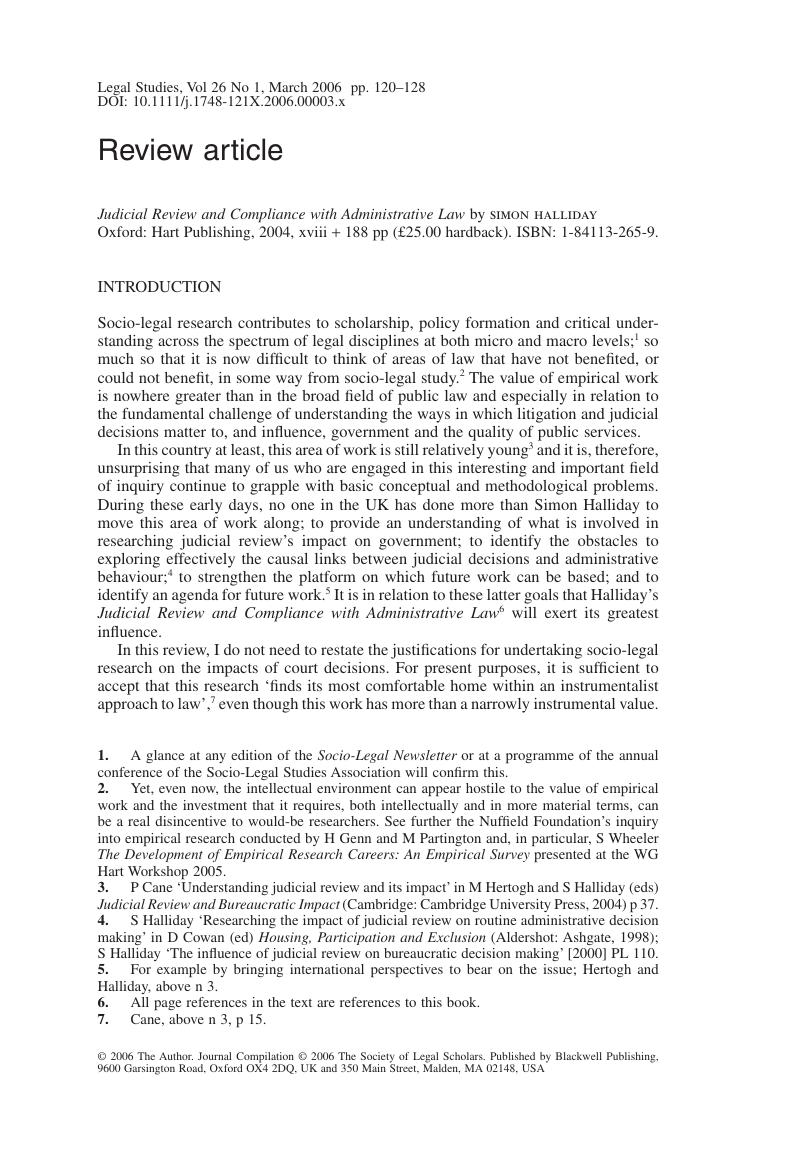Published online by Cambridge University Press: 02 January 2018

1 A glance at any edition of the Socio-Legal Newsletter or at a programme of the annual conference of the Socio-Legal Studies Association will confirm this.
2. Yet, even now, the intellectual environment can appear hostile to the value of empirical work and the investment that it requires, both intellectually and in more material terms, can be a real disincentive to would-be researchers. See further the Nuffield Foundation's inquiry into empirical research conducted by H Genn and M Partington and, in particular, S Wheeler The Development of Empirical Research Careers: An Empirical Survey presented at the WG Hart Workshop 2005.
3. P Cane ‘Understanding judicial review and its impact’ in M Hertogh and S Halliday (eds) Judicial Review and Bureaucratic Impact (Cambridge: Cambridge University Press, 2004) p 37.
4. S Halliday ‘Researching the impact of judicial review on routine administrative decision making’ in D Cowan (ed) Housing, Participation and Exclusion (Aldershot: Ashgate, 1998); S Halliday ‘The influence of judicial review on bureaucratic decision making’[2000] PL 110.
5. For example by bringing international perspectives to bear on the issue; Hertogh and Halliday, above n 3.
6. All page references in the text are references to this book.
7. Cane, above n 3, p 15.
8. DJ Galligan ‘Introduction: socio-legal readings in administrative law’ in DJ Galligan (ed) A Reader on Administrative Law (Oxford: Oxford University Press, 1996).
9. Such as D Cowan and S Halliday (with C Hunter, P Maginn and L Naylor) The Appeal of Internal Review (Oxford: Hart Publishing, 2003).
10. His empirical study was located in three local authorities: Timbergreens, Muirfield and Eastbank.
11. See Halliday's discussion (at p 74) of the distinction, drawn by Black, between formal and substantive compliance; J Black Rules and Regulators (Oxford: Clarendon Press, 1997) p 222.
12. See especially Lipsky's work on the alienating effect of street-level bureaucracy discussed by Halliday at p 59; M Lipsky Street-Level Bureaucracy: Dilemmas of the Individual in Public Services (New York: Russell Sage Foundation, 1980).
13. Cf G Richardson and D Machin ‘Judicial review and tribunal decision-making: a study of the mental health review tribunal’[2000] PL 494.
14. Halliday draws on Hertogh's work on the ombudsman and administrative courts in the Netherlands; M Hertogh ‘Coercion, cooperation, and control: understanding the policy impact of administrative courts and the ombudsman in the Netherlands’ (2001) 23 Law & Policy Review 47.
15. See Sunkin and Pick's findings on the reaction of Social Fund Inspectors to having their decisions clinically scrutinised by courts; M Sunkin and K Pick ‘The changing impact of judicial review: the Independent Review Service of the Service of the Social Fund’[2001] PL 736 at 758.
16. Including Black who emphasises the importance of dialogue in achieving mutual understanding and, thus, effective regulation; Black, above n 11; also J Black ‘Talking about regulation’[1998] PL 77.
17. On the significance of settlement, see, generally, L Bridges, G Meszaros and M Sunkin ‘Regulating the judicial review caseload’[2000] PL 651 especially at 666–669.
18. M Fordham ‘Judicial review: the new rules’[2001] PL 4; T Cornford and M Sunkin ‘The Bowman Report, access and the recent reforms of the judicial review procedure’[2001] PL 11.
19. R (Cowl) v Plymouth City Council[2001] EWCA Civ 1935 (unreported); V Bondy ‘Who needs ADR? (2004) 9(4) JR 306.
20. See M Galanter ‘The radiating effects of courts’ in KO Boyum and L Mather (eds) Empirical Theories About Courts (London: Longman, 1983); RH Mnookin and L Kornhausr ‘Bargaining in the shadow of the law: the case of divorce’ (1979) 88 Yale Law Journal 950; M Sunkin ‘Withdrawing: a problem in judicial review?’ in P Leyland and T Woods Administrative Law Facing the Future: Old Constraints and New Horizons (London: Blackstone Press, 1997) pp 221–241 at p 238.
21. One of the best recent examples of this is the strategy adopted by the Attorney-General in relation to persuading the courts of the need to show deference to government in the context of policy: ‘[w]e [government lawyers] must think about how best to present [cases]…It is here that the question of evidence – especially of policy background and considerations – becomes absolutely crucial. That evidence is essential to bring home to the court the complexity of the policy background, and the ramifications of unsettling policy decisions in what may, superficially at least, appear to be a discrete area capable of being ring-fenced’; Lord Goldsmith ‘New constitutional boundaries’ paper delivered by the Attorney-General to a Government Legal Service Conference on Current Developments in Administrative Law (22 March 2002) p 15 (emphasis added).
22. Lord Woolf in M Andenas and D Fairgrieve (eds) Judicial Review in International Perspective (The Hague: Kluwer Law International, 2000) p 435.
23. M Adler ‘A socio-legal approach to administrative justice’ (2003) 25(4) Law & Policy 323.
24. R v Lancashire County Council, ex p Huddleston[1986] 2 All ER 941 at 945.